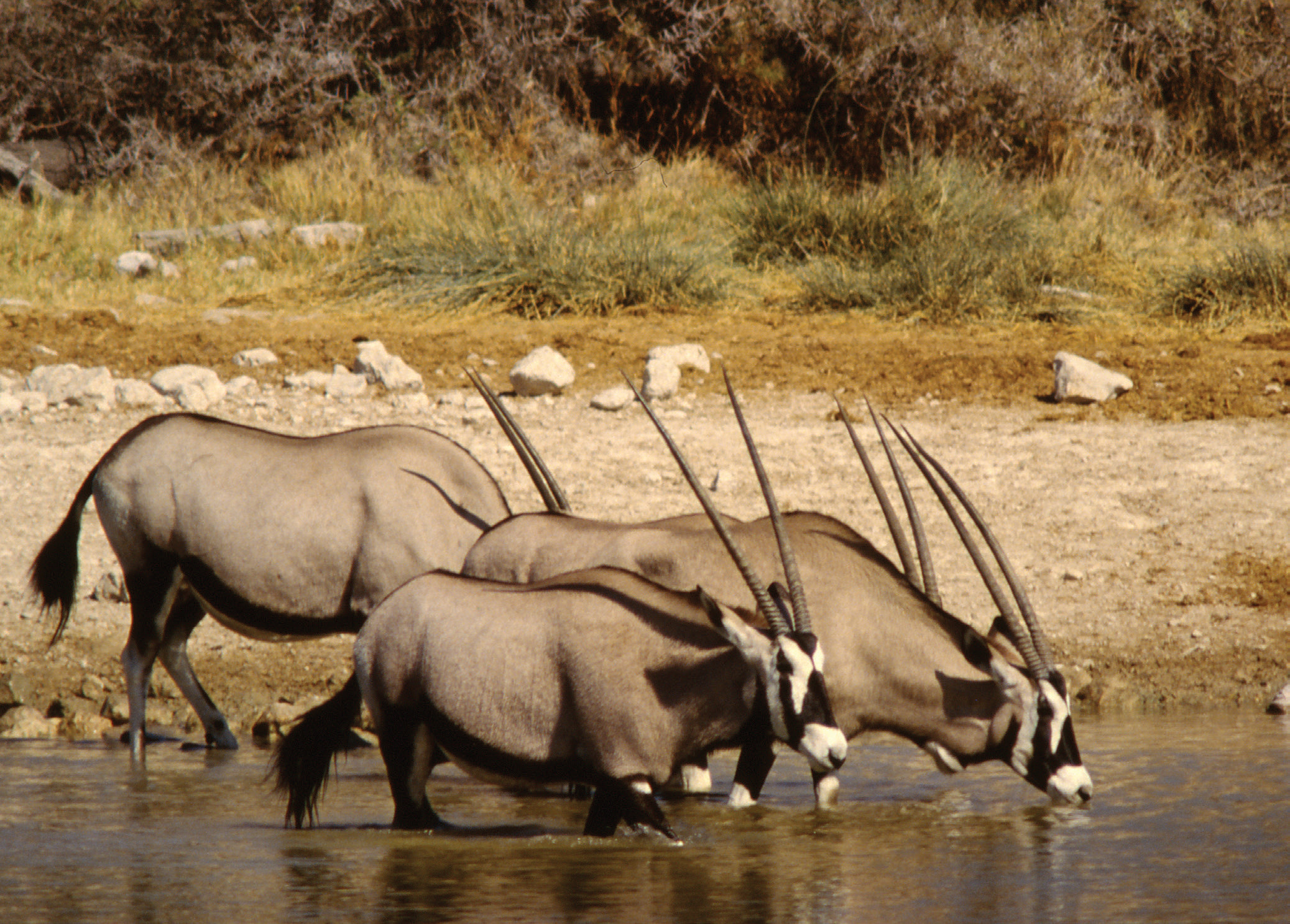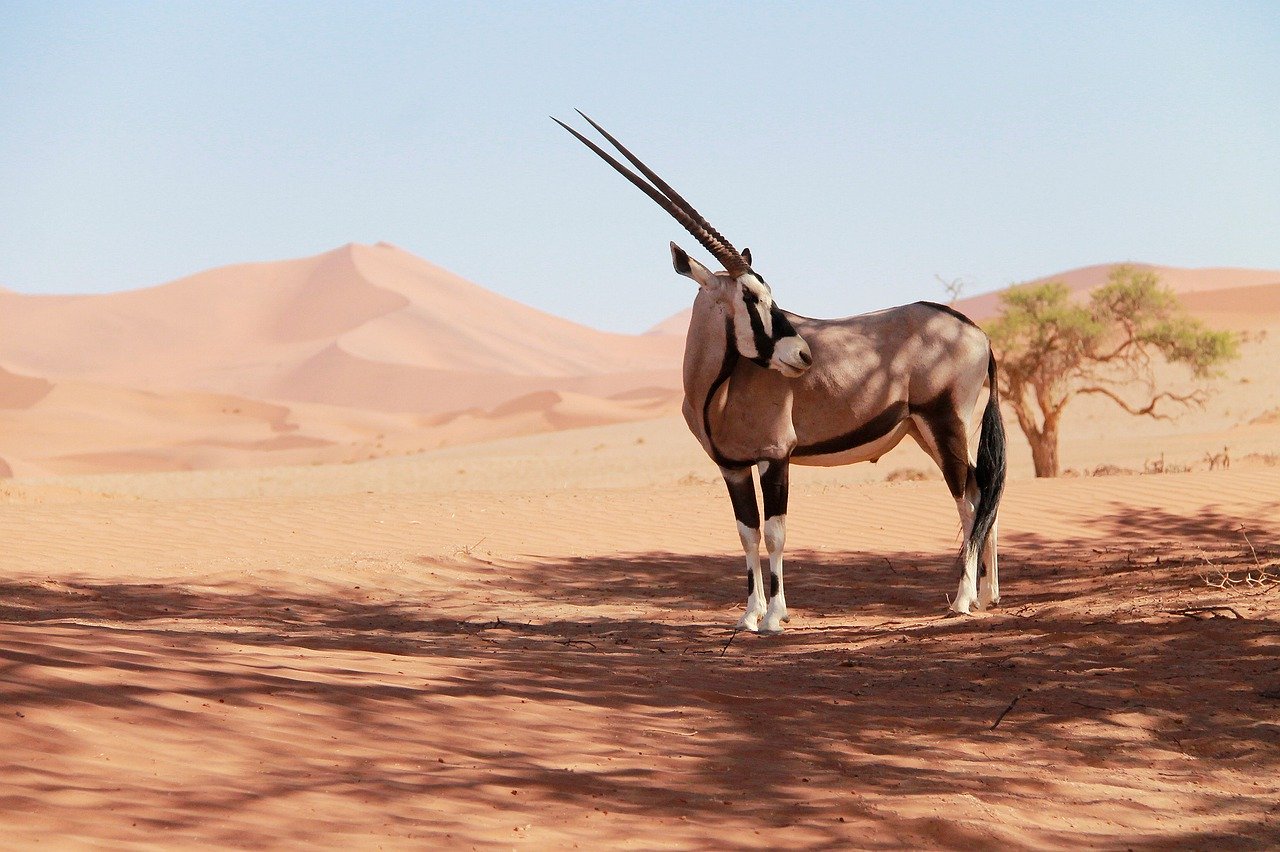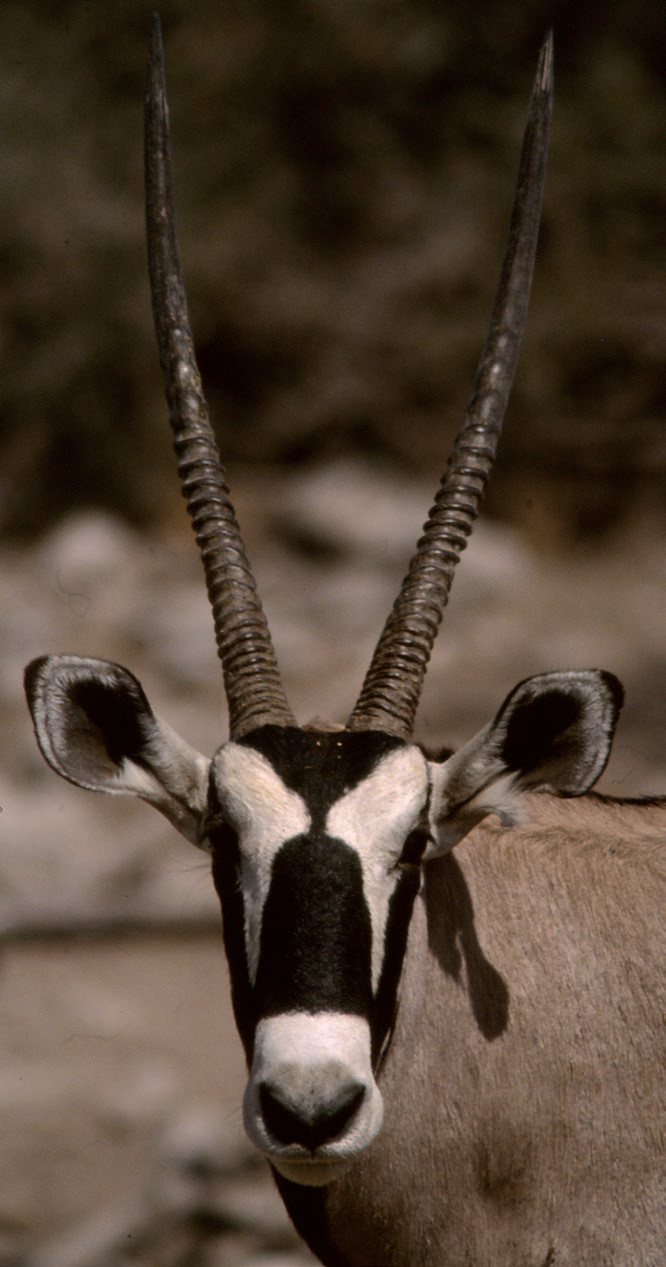Daybreak finds us sitting close to the camel thorn fire, for the morning air is chilly. Soon the kettle boils and coffee is brewed. Another day on the arid hunting grounds awaits. My hunting friend Lance and I have pursued many animals with some success, but it is the gemsbok, Namibia’s most formidable swordsman, which Lance so dearly longs to track, test his skills against, and hunt…
This particular gemsbok has grazed throughout the night to escape the heat of the desert’s scorched lands. It now stands in the direct sun, with burning sand under its hoofs, shifting its weight now and again. It hasn’t had water on its blackened tongue for weeks. It has maintained its diet by scenting out roots and bulbs, and digging them out of the sand with its strong, sharp, heavy hoofs, quenching its thirst by lucky finds of moisture. When Africa is conjured up in the mind, many see lush savannahs and jungles. But the Kalahari and Namib deserts are regions defined by drought, and they test survival on a daily basis, of both man and beast.
Lance and I have left camp early, grateful for the blessed coolness of morning with its refreshing dew. From years of a semi-sedentary life, he has been unable to cope with discomfort and irritation. We walk in a landscape that consists of vast level plains, haunted by mirages, sand dunes, with arid mountain ranges – usually mere piles of bare rock. Soon the sun sucks the last drop of moisture from the air and sands.
We push on. We see some bustards and snakes, and groups of springbok in the distance. We climb to the top of a small dune, lie down and carefully scan the plains from east to west. A faint breeze swirls over our perspiring bodies. While we lie there, a jackal shambles up the steep slope of loose sand and meets us, face to face. It regards us with bewilderment for a second and then dashes back with a yelp. Lance and I exchange glances as we wordlessly share this moment. The heat has now reached full force with temperatures must be around the 40s.
“Let’s push on and forget about the heat,” I try to motivate my friend. The sun beats down fiercely, and the sand over which we trudge burns through the soles of our shoes. On the right, a small thicket of black sticks becomes visible, standing at various angles. The rest of the gemsbok is out of sight, nothing visible but the long and straight horns. But as we near them, the thicket of “black sticks” becomes agitated. It breaks up, scatters and regroups in smaller thickets. Then the herd of gemsbok swings away at a gallop and speeds upwind, leaving a long trail of dust to mark its course and finally melting into the mirage.
Far off, ahead of the herd, the aristocrat of the desert, a lone bull is resting in the mid-day haze under the scant shade of a tree, surrounded by miniature pyramids of dry gemsbok droppings, where he has marked this area as his territory. He left the herd months ago, leaving the females to their fate. They have their own lethal set of horns to defend themselves and their young. He is old and tired, and the natural instinct to pass on his genes for future herds is long lost. He faces the slight breeze, pants, inhales and exhales rapidly through his nose, a nose lined with a network of small blood vessels that are cooled by the air pulled into the nose to ensure that blood enters his brain at a lower temperature.
Lance and I don’t escape our share of hardship. We carry our own water, but that previously cool refreshment has now warmed to a hot tea temperature. Even so, we drink it gratefully. The heat reflecting off the ground and stones is almost unbearable, but we are able to endure it while moving. But the stillness of the desert and the glare from the surroundings is weighing Lance down.
“Shade – coolness – where is it,” he asks. “Even darkness would be a relief.” I realize that something approaching desperation seizes him, and I feel close to calling it a day and turning back. But then I spot a tree in the distance towards the west. As Lance turns to face a slight breeze, he regains some enthusiasm and puts my thought into words: “Wind in your face, sun at your back.” With renewed hope we turn westward and head for the shady tree. Suddenly, and with our sights set on tree in the distance, three gemsbok calves rise at about sixty meters and stare at us.
About three to four months old, they are a most extraordinary sight. Their necks, chests and flanks are covered with long vivid red hair. They have shaggy red manes and big, black, muzzles; their ears are enormous. Lance mistakes them for lion and becomes terrified, until I tell him what they are. Once his adrenaline rush subsides, we are able to continue. The gemsbok calves gallop off in confusion, sweeping left and right, and finally speeding towards the direction where we last saw the big herd disappear. I admire their agile movements in the rocky terrain, which poses no obstacle for gemsbok – the divisions of their hooves, connected by a strong membrane of muscle, expand widely and stretch apart when they tread on a stone, the membrane serving as a supporting spring.
And then, as we look back to the lone tree with its inviting coolness, I spot the slight movement of a white underbelly beneath it, and whisper excitedly to Lance to look at it though his binoculars. Finally, with sweaty fingers slipping and sliding over the warm binoculars, Lance lays eyes on the striking beast. We gaze at the black and white patterns around its legs and underbelly, the iconic facial markings that deflect the heat and make the gemsbok so stunningly beautiful. It is the result of a long period of evolution to make him attractive in the eyes of the females of his species. He is a mere 200 meters away, still facing away from us.
Lance and I swiftly move closer, he crouched low, my head bent downwards, hoping that the gemsbok will not sense us closing in on him. But when, at 120 meters away from the gemsbok I raise my head to take a quick look, it is as if he had read my mind – the famous sixth sense of the gemsbok has already kicked in. He is facing us now. He stands statue-like, defying his enemy, his muscular shoulders and flanks, tense, his wiry hair erect and quivering. His trumpet-shaped red nostrils seem to exude defiance.
I look at his deadly weapon, the long, slim, pitch-black horns shimmering in the sun, and a quick thought plays with my sub-conscience… that the gemsbok, without breaking his stride, can sweep his formidable horns as quick as lightning and impale anything within a meter on either side of him. And suddenly, at this moment I am not eager for Lance to shoot. It is enough to simply gaze at the impassive face. I, the hunter, who with my friend, so much longed to take this formidable swordsman, now just want to revere him.
The hunter’s instinct is one which is most deeply rooted in the mind of man. As Lance slowly lifts his rifle to his shoulder – a second too late, a deliberate moment too long spent scrutinizing the beast before us. The gemsbok turns and trots off, as if challenging us to follow. Lance follows him only through his scope, lowering his the rifle as the gemsbok pauses on top of a dune It catches the evening breeze, and gazes down on us one last time. I realize that Lance had had the same fleeting emotion pass through him.
Day faded, and the dome of stars seemed to be drawn around us. How intensely still it was, how utterly peaceful, where Lance and I seemed to have reached Nirvana.
The gemsbok has several interesting peculiarities. Namibians think so highly of the gemsbok Oryx gazella, that the national coat of arms depicts two of these magnificent animals representing courage, elegance and pride, on either side of a shield covered with the national flag. If you see these antelope in their desert surroundings you will immediately understand their prominent place in the hearts of Namibians.





